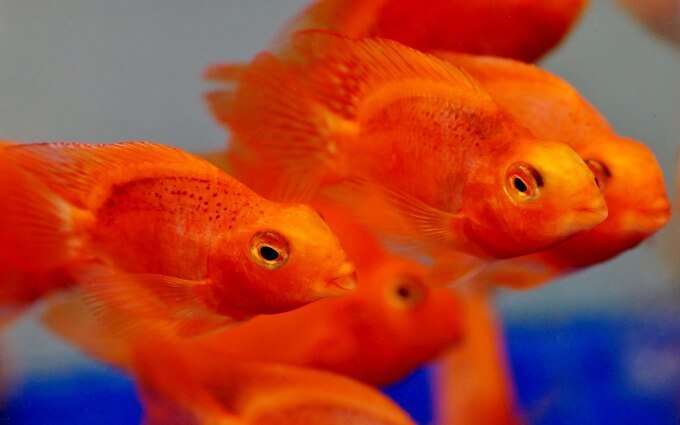
Size
One of the bigger cichlids is the blood parrot. Adult males grow to be 8 inches long, while adult females grow to be 6 inches.
Physical Appearance
The moniker “blood parrot cichlid” refers to the fish’s big, parrot-like eyes and beak-like head. These cichlids are calm neighbourhood fish with reserved personalities.
A blood parrot cichlid has a stunning brilliant orange body and translucent fins that cascade. The rarest colour of these fish is grey, though few are yellow and red as well. Some unscrupulous fish breeders dye their fish to get new colors, which reduces the fish’s life expectancy.
Large eyes, broad fins, and beaks resembling those of parrots make blood parrot cichlids simple to identify. Adult males are taller and leaner than adult females, and females have bodies that are plumper.
Unfortunately, hybrid breeding has resulted in genetic defects in blood parrot cichlids. The fish has huge nuchal fins in comparison to its head. The narrow mouth of the blood parrot cichlid opens vertically, cannot close properly, and has a row of teeth that extends down its neck, which prevents it from swallowing.
Habitat
The hybrid blood parrot cichlid was first discovered in Taiwan in 1986. The Mexican redhead cichlid (Paraneetroplus synspilus) and the Costa Rican midas cichlid (Amphilophus citrinellus) were crossed by the Taiwanese. Freshwater fish from rivers and basins were the progenitors of both cichlid species.
Keeping as Pet

Water Parameters
Similar water conditions are preferred by blood parrot cichlids. They prefer warm, year-round waters that are somewhat acidic. To keep your aquarium cozy for these fish to reside in, use the following settings:
Water temperature: 76°F to 80°F
pH levels: 6.5 to 7.4
Water hardness: 6 to 18 dGH
Tank Size
One Blood Parrot Cichlid requires a tank that is at least 30 gallons in size. These fish need a lot of space to swim because they are quite active.
Larger tanks are, of course, always appreciated. A small group of these fish are popular among aquarists to keep together. Choose a tank that is 60 gallons or larger in that situation.
Diet and Feeding
Since there are no wild blood parrot cichlids, they lack a natural diet. The optimal diet for this species is one that is diverse and contains both protein and pellets. Cichlid pellets that are dry-formulated perform nicely. Feed the fish brine prawns and high-protein bloodworms three times per week for protein.
Use sinking pellets since blood parrot cichlids can’t consume food from the water’s surface. Three times per day, keep feeding times to a few minutes each. To keep the water properly hygienic, remove any extra food.
Tank Mates
When kept in a communal tank with other calm fish or other blood parrot cichlids, these fish make wonderful pets. Never keep this species with fish that are aggressive. These fish make excellent aquarium mates for blood parrot cichlids:
Danios
Medium tetra
Catfish
Angelfish
African cichlid
Firemouth cichlid
Kribensis cichlid
Honey gourami
Dwarf gourami
Clown pleco
Tiger barb
Table





